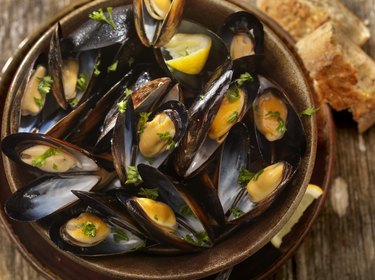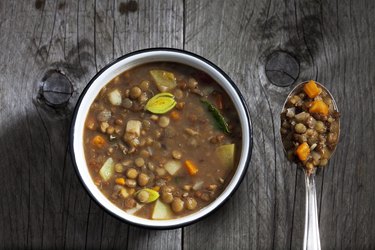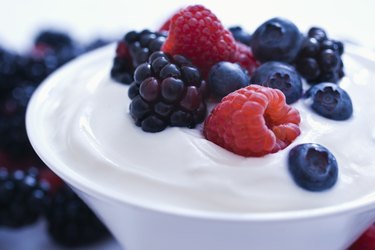
We're living in a time of diet fatigue: There's a never-ending onslaught of diet trends, fad diets and challenges in play. And many of us have had years of perpetual "dieting" with little to no long-term success to show for it. So if you've decided you want to lose some weight, where do you go from here?
What if instead of being vigilant about what you're cutting from your diet, you focused on what you're adding instead? In other words, instead of jumping on the keto diet bandwagon and banishing carbs or going sugar-free for a week, month or any other timeframe, you can switch your focus to adding healthy foods to your life — ones that are a source of carbs, fat and protein.
Video of the Day
Video of the Day
Our bodies need all three of these macronutrients to be healthy and function properly and there are healthy ways to meet these needs, especially if you're trying to lose weight.
Protein and Weight Loss
When it comes to losing weight, ensuring you're getting enough protein (please note: this does not mean eating exorbitant amounts) will help you meet your goals more efficiently. Here's why:
- Protein is satiating: Compared to carbohydrates and fat, protein is generally more satiating, i.e., after eating a meal with ample protein, there is a greater feeling of fullness, per an April 2015 paper published in the American Journal of Clinical Nutrition (AJCN). When you're trying to lose weight, eating foods that help you feel satisfied and full will keep you headed in the right direction.
- It helps maintain lean mass: When we reduce our calorie intake and begin to lose weight, it's never just fat we're losing — inevitably, we lose some muscle, too. But, by eating enough protein, and not drastically cutting your calories, we can minimize the amount of muscle lost. Why is this important? Lean muscle mass is more metabolically active than our fat stores — that is, it keeps our metabolism up.
- Digesting protein burns more energy: It takes energy to digest the food we eat and it turns out, protein requires the most. The April 2015 AJCN article shared that it takes 20 to 30 percent of its useable energy to process protein, while carbs required just 5 to 10 percent and fat requires zero to 3 percent.
How Much Protein Do You Need?
The Recommended Daily Allowance (RDA) for protein is 0.8 grams per kilogram, as established by the Food and Nutrition Board of the Institute of Medicine, National Academies. But if you work out regularly, are an athlete or have an active job where you're on your feet most of the day, you mostly likely need more.
Go beyond the RDA if you're looking to lose weight or build muscle, too. A December 2019 study published in Advances in Nutrition reviewed the findings of 18 different studies and found that while the RDA is appropriate for everyday needs, you should up your protein intake to 1.3 grams per kilogram per day (keeping in mind that a kilogram equals 2.2 pounds) in those two scenarios.
This is part of the reason why grilled chicken breast, egg whites and cottage cheese are commonly found on many weight-loss diet plans. But there are more exciting sources of protein that are also advantageous when it comes to weight loss — here are six foods to try (along with a few to avoid).
6 Proteins to Eat if You’re Trying to Lose Weight
1. Lentils

All pulses (beans, legumes and peas) are a great source of protein — we're calling out lentils because they're some of the highest in protein and are so versatile.
A half-cup of cooked lentils has just 100 calories while providing 9 grams of protein and 7 grams of soluble and insoluble fiber, which helps keep you regular, and feeling fuller longer, according to the USDA. This is more than twice the protein found in quinoa — a half-cup of the cooked grain has 111 calories, 4 grams of protein and 2.5 grams of fiber, per the USDA.
Related Reading
2. Nutritional Yeast
Don't sleep on this one. Nutritional yeast is big in the plant-based world but even carnivores and dairy consumers will enjoy it. The flakes have a cheesy flavor — great for adding to popcorn or homemade kale chips and is great when making sauces, too.
A one-fourth cup serving of nutritional yeast contains 60 calories, 0 grams saturated fat, 5 grams of carb, 3 grams of fiber and 8 grams of protein, according to the USDA. It's also super-rich (as in over 100 percent of the Daily Value) of thiamin, riboflavin, niacin, folate and vitamin B12.
3. Chia Seeds
We typically think of nuts and seeds as source of fat but they're also a source of protein and fiber — which is a winning duo when it comes to losing weight. Two tablespoons of chia seeds provide 130 calories, 6 grams and 10 grams of fiber(!), per the USDA. There's also 7 grams of fat, some of which are omega-3 fatty acids.
One thing we love about chia seeds is that they swell when combined with a liquid, adding volume and helping to keep us feeling full. Hemp seeds are great too and fairly comparable nutritionally but they don't have near the fiber or ability to expand in size.
Related Reading
4. Mussels
Most seafood is a great source of protein from salmon to shrimp, but we're calling out mussels because of their nutritional status and sustainability when it comes to supporting the environment.
A 3-ounce serving provides 146 calories and 20 grams of protein, per the USDA.
Mussels are also low in mercury according to the Environmental Defense Fund (EDF). Plus, mussels are a protein you can feel good about eating: These mollusks keep water clean by filtering out heavy metals and other biological matter and, when farm-raised on ropes, the harvesting process has minimal strain on the environment compared to dredging off the sea floor, per the EDF.
Related Reading
5. Yogurt

Yogurt is a great protein source and is available in fat-free to full-fat, providing options depending on preference, health concerns or culinary needs. A cup of plain non-fat yogurt has 130 calories and 13 grams of protein, according to the USDA — that makes it a great option for vegetarians.
Most yogurts on the market today contain probiotics, which support our gut health and may have different health benefits, depending on the strains in the yogurt.
Vegans can get in on the action, too. More dairy-free options are becoming available, just make sure there's a protein source like soy or pea protein. You can find some products with 10 grams per container (about 5.3 ounces).
6. Tempeh
You may already be hip to tofu but have you tried tempeh? To start, they're related in that they're both soy-based. In fact, tempeh is fermented soybeans so it has the protein soy provides but is also good for our guts because it's a fermented food.
A 3-ounce serving of cooked tempeh provides 165 calories and 17 grams of protein, per the USDA — who says eating protein on a plant-based diet is hard? You'll want to season tempeh with a sauce or spices.
Tempeh is also a good source of iron, a mineral that delivers oxygen to our cells, which gives us energy to exercise and be active. Women have a higher risk of developing iron-deficiency anemia, according to the National Institute of Health.
Limit These 3 Protein Sources
1. Processed Meats
Hot dogs, salami and bacon are all processed meats. While these foods all have protein, they're also high in saturated fat, which is harmful to our hearts.
There's also a large body of evidence linking red and processed meat consumption to type 2 diabetes, cancer and cardiovascular disease, although these are largely epidemiological studies, which show a link, not cause and effect, as outlined in a February article published in Diabetes Care from the American Diabetes Association.
That said, short-term clinical trials have found that swapping red meat with plant-based protein (like some mentioned above), reduces LDL cholesterol and other risk factors of heart disease.
Related Reading
2. Sugary Yogurts
When it comes to yogurt, plain, unsweetened flavors are free of added sugar, but if that's tough to swallow (literally), look for options lower in added sugar.
There are plenty of options available — in both dairy and non-dairy categories. Aiming for 8 grams or less is a great place to start. We overdo it when it comes to added sugars. On average, we consume about 17 teaspoons of sugar per day, but the American Heart Association recommends no more than 6 teaspoons for women and 9 for men.
3. Tilefish, Swordfish, King Mackerel, Etc.
Fish and seafood are good sources of protein but some come with a side of heavy metals, namely, mercury. Tilefish, swordfish, king mackerel, orange roughy, marlin and more are considered to be high in mercury, according to Natural Resources of Defense Council.
You want to avoid eating these foods. Healthier options include mussels, scallops, skipjack tuna and salmon.
- American Journal of Clinical Nutrition: "The Role of Protein in Weight Loss and Maintenance"
- Food and Nutrition Board of the Institute of Medicine, National Academies: "Dietary Reference Intakes (DRIs): Recommended Dietary Allowances and Adequate Intakes, Total Water and Macronutrients"
- Advances in Nutrition: "Protein Intake Greater than the RDA Differentially Influences Whole-Body Lean Mass Responses to Purposeful Catabolic and Anabolic Stressors: A Systematic Review and Meta-Analysis"
- MyFoodData: "Cooked Lentils"
- MyFoodData: "Quinoa Cooked"
- MyFoodData: "Bobs Red Mill Natural Foods Inc. - Large Flake Nutritional Yeast"
- MyFoodData: "Organic Whole Chia Seeds"
- MyFoodData: "Hemp Seeds"
- MyFoodData: "Cooked Blue Mussels"
- nvironmental Defense Fund: "Mussels"
- MyFoodData: "Nonfat Plain Yogurt"
- Siggis: "Plant-Based"
- MyFoodData: "Tempeh Cooked"
- National Institute of Health: "Iron: Fact Sheet for Consumers"
- Diabetes Care: "Red and Processed Meats and Health Risks: How Strong Is the Evidence?"
- American Heart Association: "Added Sugars"
- Natural Resources of Defense Council: "Mercury Guide"